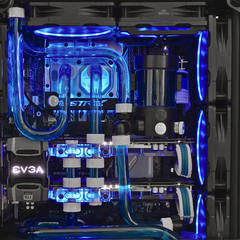-
Posts
52 -
Joined
-
Last visited
Awards
This user doesn't have any awards
Recent Profile Visitors
935 profile views
GlorifiedPaperShuffler's Achievements
-
So in two weeks, I'll be closing on a new house. All the paperwork's been signed, and I'm looking forward to becoming a homeowner after years of renting. I had it all planned out. Gonna run CAT-6A Ethernet indoors and outdoors. Full suite of Ubiquiti products, from UniFi Dream Machine Pro, UniFi APs, UniFi POE switches, UniFi Protect cameras, etc. etc. Then a couple days back, Ubiquiti comes out and announces EOL on some products, leaving a bunch of very angry users and vendors. That kinda shook my confidence in Ubiquiti, and in my planned setup. Perhaps it isn't such a bright idea to go all-in on one single manufacturer? Worse, further research into the Dream Machine Pro revealed a litany of network breaking bugs (one user's Dream Machine Pro apparently likes to occasionally disable all its ports). I don't run a business, so I don't need 100% uptime. This network is for my own home use. But I don't want to deal with problems that I can avoid. Basically, I need help planning a new network and CCTV suite. I was pointed at Ubiquiti's products via LTT's videos, so I'm not familiar with other manufacturers. What I need from my network: A WiFi "mesh". I don't want a true mesh network, where some WiFi bandwidth is used by APs to as a backhaul. I just want full coverage all over my house, from the basement, to the bedroom, to my backyard, all running off the Ethernet infrastructure I'll be laying down, with enough throughput to stream 4K video from my Unraid NAS, and move huge files between devices. Intrusion detection and prevention - A firewall. I currently have a pfsense SG-3100 router, and it's "alright". It's just way too complicated to do anything. I remember spending a few hours just trying to get Destiny 2 to run properly. Optional but nice - a pretty dashboard to show if the Russians are trying to get into my network or something. DPI, or at least, the ability to gather statistics on what devices on my network are doing. Some way to isolate IoT devices from the general network, like a VLAN. I'll be running a HomeKit suite of devices, so I'd like these IoT devices to be able to communicate with some hubs (Apple TV, Pod, iPad), but nothing else unless I periodically allow it for updates. What I need from my CCTV (estimated 5-6 cameras): PoE powered cameras, to minimize the amount of wiring I'll need to add. I don't want completely wireless cameras either. 4K resolution for some cameras, full HD for others. If the cameras catch anything, I'd like to be able to identify the perps. Blurry video is not acceptable. Some intelligence built into the system, where it only records if movement is detected in specified areas of the camera's view. Good IR range for nightvision. Local NVR recording only. I'd prefer not to have my system upload anything to anywhere else besides my home NVR. Any suggestions? Thanks in advance.
-
Welp, I learned a few new things about building computers today. 1) Don't be a hero. There's a reason why nobody has tried to build a computer, and manage cables like automotive harnesses. This experiment was an abject failure, and it created so much more bulk and frustration that made it almost impossible to manage cables properly. It's why real harnesses are built with individual wires cut-to-length. I had to replace all the power cables I screwed up trying to make harnesses (removed the shrink wrap), and had to clean up, so here's a before and after: 2) Hard line bending is hard. Linus and JayzTwoCents make it look too easy. It took me the better part of 6 hours today to make 3 lines (plus lots of scrap lines). Here's my first bend ever: I feel like it's not going to be water tight, but we'll see. And here's how far I've made it so far: Nothing in this PC lines up "properly" for some reason, so there's lots of gentle 45 degree bends to get the lines into the fittings. Wish me luck.
-
I have a Cooler Master Cosmos C700M, that I intend to paint with automotive tri-coat spray paint. My intended result is for the surface to end up like a car's surface. Do I first have to sand down the brushed aluminum surfaces till they're flat? How can I achieve best results?
-

Technica: A Subaru Themed PC. My Magnum Opus
GlorifiedPaperShuffler replied to GlorifiedPaperShuffler's topic in Build Logs
Too bad they don't make em anymore. Oh well, at least with a processor you can just delid and fill the insides with liquid metal. -

Technica: A Subaru Themed PC. My Magnum Opus
GlorifiedPaperShuffler replied to GlorifiedPaperShuffler's topic in Build Logs
Probably clear, because I'd rather not risk problems. Fans will be RGB, but I have not decided which fan yet. There are a few fans that carry a linear RGB design, instead of circles. I'm still researching if demanding a linear RGB design will mean compromising performance. On the other hand, circles don't really fit all that well in the design I have in mind. I saw their website, and it's mighty tempting. The cheap price helps too, because I intend to paint the radiator's side panels (leaving the fins black). It'll be nice if they're cheap to replace if I screw it up. I know the feeling man. To get the money to do this and other things, I gave up a year of my life for my employer, and worked in our HQ in Japan for that time. -

Technica: A Subaru Themed PC. My Magnum Opus
GlorifiedPaperShuffler replied to GlorifiedPaperShuffler's topic in Build Logs
Absolutely it'll be hardline! I'm currently thinking of a way to evoke the Boxer Engine with my hardline routing. See where it'll take me. I'm kinda torn between just running blue coolant, or if I should try to color match the Cherry Blossom Pink/Red by mixing coolants. Not sure if the latter will result in problems. I'm currently partial towards EK rads really, though I'm perusing Alphacool's range as well. I'll check out Hardwarelabs. No harm in doing so. I forgot to mention...the hardline loop fittings will be gold! -
In my other build log, I called my wife's build "The Guinea Pig". A guinea pig for what you might ask? Well, here is a build I call "Technica", named after Subaru Technica International (STI), the motorsports and high performance division of Subaru (the car manufacturer, not the telescope). The parts list isn't finalized yet, since I estimate it'll take me months just to do the mods I have planned for the case. But think Ryzen 9, 2080 Ti, all watercooled, RGBed to the max, plus a good helping of automotive grade paint. This is my dream build. It's been about 6 months in conceptualization. For the longest time, I referred to it in my budget/parts sheet as "Magnum Opus", because I think this will be the last major build I do from scratch. Everything after will just be updates to the internals here and there. The build's theme is Subaru, but specifically, the design will try to evoke themes found in the following Subarus: So lots of WR Blue (I'm partial towards WR Blue Pearl), a touch of Cherry Blossom Red/Pink (undecided if I should harken back to the original pink or the newer pinkish red), and just a touch of High Viz Yellow. I'm starting this thread today, because today is the day the case for this build arrived: Yes, I am a nutjob who just paid for a C700M. My fingers are tightly crossed that this case will be the last case I buy. Beyond this, I hope everything will just be a matter of upgrading internals. If you are thinking of buying a Cosmos C700M, know that it is a MASSIVE case. My wife's Crystal 570X looks like a toy next to it. Yes, this also does mean that I got parts for a 2nd build before finishing the 1st. I'm hoping to take advantage of what remaining warm weather we have outside for painting. Additionally, I can do more detailed planning with the case in-hand, so I can see what I can take apart for painting, and how I can best apply the color theme discussed above. Will update when I make more progress.
-
Today I did more test fitting. Honestly, I should've done this at the start. With the Cablemod vertical GPU bracket, it pushes out the GPU some towards the front. Then couple that with my overambitious choice of an XR7 radiator. Corsair should've just called this radiator the Thiccboi. There's basically no room left to mount the reservoir: I don't know if it's "alright". There's basically 1-2mm clearance from the radiator, which means there's next to no room at all when it comes time to install the hard line water loop. I'm slightly concerned about noise when the pump operates, since it is touching the PSU shroud. What would your advice be?
-
I only had a few hours today to make some progress with this build. Initially I had wanted to plan the routing for all the wires in this computer, but it became too much to keep track of. So I decided to say, "fuck it", and just make up the routing as we went along. I put in the MB, top radiator, and a few fans: But what I'd like to focus on in today's log is a little experiment for cable management (see the USB 3.0 cable sticking out near the bottom?). Originally I had wanted to buy some nice custom length cables from Cablemod, until I found out how goddamned expensive they were, and even after that, there was no guarantee that I could give them the precise measurements needed. So after some thought, I realized that IRL I am an automotive engineer, with 50% of my work being automotive harnesses. Why not apply the same construction methods to PC cable management? I experimented a little with the USB 3.0 cable, and I think the results look decent. Additionally, with automotive harness construction methods, you could get the cables to stay in certain shapes ("forming" or sometimes "dressing"). Also, there is a myriad of additional accessories you could buy online (if you know their part numbers) to enable even more ways to manage cables. You can even bundle multiple cables together that are going the same route, and you get a nice clean run of cables. What do you guys think?
-

build logs The Guinea Pig: High End Rig For The Wife
GlorifiedPaperShuffler posted a topic in Build Logs
For months now, I have been planning to build two high end rigs for me and the wife. The wife's system will be built first, because ladies first, and also because I've never done hard line water cooling before, so I need a guinea pig. Her rig will be high end for sure, but it'll just be a generic high end rig. It'll serve as the test bed for many things, including hard line bending/cutting, water block installation, Corsair's iCue, HydroX parts, X570, Ryzen 3rd Gen, and RTX games. We've got the furniture for a twin battlestation area last weekend. Today, the first set of tools arrived. I figured the Eiskoffer will give me the best chance of pulling this off well the first time around. Actual construction will begin this Labor Day weekend. Total budget for her rig is $3800. Parts list: PCPartPicker Part List Type Item Price CPU AMD Ryzen 7 3700X 3.6 GHz 8-Core Processor $327.79 @ OutletPC Motherboard Asus PRIME X570-PRO ATX AM4 Motherboard $236.89 @ OutletPC Memory Corsair Vengeance RGB Pro 32 GB (4 x 8 GB) DDR4-3200 Memory $199.99 @ Amazon Storage Corsair MP600 Force Series Gen4 1 TB M.2-2280 NVME Solid State Drive $249.99 @ Best Buy Video Card NVIDIA GeForce RTX 2080 SUPER 8 GB Video Card $699.99 @ Best Buy Case Corsair Crystal 570X RGB ATX Mid Tower Case $189.98 @ Newegg Power Supply Corsair 860 W 80+ Platinum Certified Fully Modular ATX Power Supply Case Fan Corsair LL120 RGB White with Lighting Node PRO 63 CFM 120 mm Fans $119.99 @ Amazon Case Fan Corsair LL120 RGB 63 CFM 120 mm Fan $35.99 @ Amazon Case Fan Corsair LL120 RGB 63 CFM 120 mm Fan $35.99 @ Amazon Case Fan Corsair LL120 RGB 63 CFM 120 mm Fan $35.99 @ Amazon Keyboard Corsair K70 RGB MK.2 SE Wired Gaming Keyboard $179.99 @ Amazon Mouse Corsair M65 RGB ELITE Wired Optical Mouse $54.86 @ OutletPC Custom Hydro X Series XD5 RGB Pump/Reservoir Combo $154.99 Custom Hydro X Series XF Hardline 14mm OD Fitting Four Pack — White $25.99 Custom Hydro X Series XC7 RGB CPU Water Block (115X/AM4) $74.99 Custom Hydro X Series XR7 360mm Water Cooling Radiator $114.99 Custom Hydro X Series XR5 240mm Water Cooling Radiator $59.99 Custom Hydro X Series XG7 RGB 20-SERIES GPU Water Block (2080 FE) $149.99 Custom Hydro X Series XF Hardline 14mm OD Fitting Four Pack — White $26.99 Custom Hydro X Series XF Hardline 14mm OD Fitting Four Pack — White $26.99 Custom Hydro X Series XF Ball Valve — Chrome $19.99 Custom Hydro X Series XT Hardline 14mm Tubing $19.99 Custom iCUE Commander PRO Smart RGB Lighting and Fan Speed Controller $74.99 Custom Hydro X Series XL5 Performance Coolant 1L — Purple $17.99 Prices include shipping, taxes, rebates, and discounts Total (before mail-in rebates) $3165.32 Mail-in rebates -$30.00 Total $3135.32 Generated by PCPartPicker 2019-08-28 23:37 EDT-0400 I'm opening this thread first and foremost to log the build process, so you can laugh at our mistakes, and maybe I can also learn something, but also because when I'm spending this kind of money, I'd like someone else to at least know about it. We're both sorta introverted people who don't often welcome guests in our home. So no one will probably ever see the rigs in-person. -

Linux Script to Flatten Directory Structure
GlorifiedPaperShuffler replied to GlorifiedPaperShuffler's topic in Programming
Maybe I'm a dummy, but I'm getting: bash: ./file_walker: /bin/python3: bad interpreter: No such file or directory Am I doing something wrong here? Never mind. I got the script to execute, but it isn't exactly what I'm trying to achieve... It basically goes through the directory, and just dumps the files into a fixed directory. I need it to recreate the folder structure on the other end. There are 160+ folders in the gdrive, hence it'd be nice to not have to execute the script manually 160+ times. I need to make a script that will recreate those 160+ folders. i.e., flatten the target folder's structure, but not completely, in another folder. End result is: cleandrive: -lvl1fld1 -lvl1fld2 -lvl1fld3 -lvl1fld4 So on and so forth until it reaches lvl1fld160 -

Linux Script to Flatten Directory Structure
GlorifiedPaperShuffler replied to GlorifiedPaperShuffler's topic in Programming
Doesn't that just dump everything into cleandrive? -
First, I'm not sure if this belongs here or in the Linux section, so mods, please move it as you deem appropriate. I'm a total newbie to writing Linux scripts. But I have a mega server I just built, so I'm in the mood to play a little and learn something new along the way. I want to write a script to clean up a particularly messy Google Drive directory that I have mounted in a Mint XFCE VM. It's the result of years of "I'll just put this here for now". They're structured something like this: gdrive: -lvl1fld1 --lvl2fld1sfl1 --lvl2fld1sfl2 ---lvl3fld1sfl2ssfl1 -lvl1fld2 -lvl1fld3 --lvl2fld3sfl1 -lvl1fld4 The folder structure can be many levels deep..., and there are literally 16000 files in there. I don't want all 16000, just certain files (e.g., I have no need to keep random .txt files or thumb.db files since this is Linux). So I want to write a script that will flatten the structure for me, while keeping only the relevant files. Thus, my current thinking is that the script needs to perform the following: Recursively scan the folders to obtain a list of files that have the specified extensions (extension whitelist). Move all files to another main folder, into the appropriate folders named according to the original lvl1 name. Leave the rest behind in gdrive as garbage for me to manually confirm that they are no longer needed. As a result, I should end up with 2 folders. One is the gdrive folder above with the garbage left behind, and another is a cleandrive folder with the following structure: cleandrive: -lvl1fld1 -lvl1fld2 -lvl1fld3 -lvl1fld4 Where should I start?












.png)

